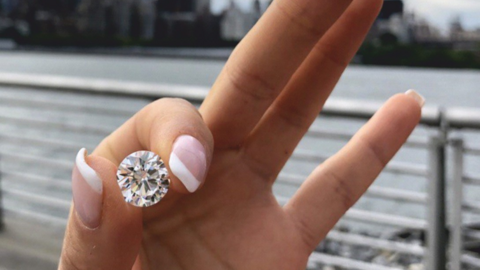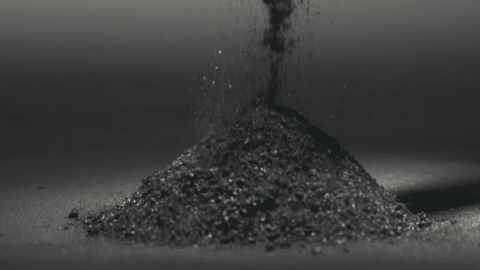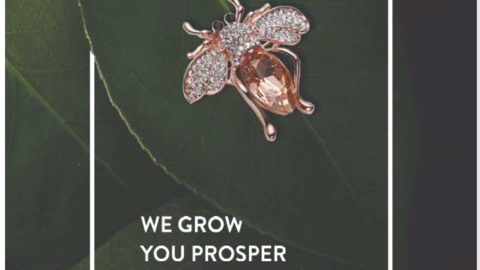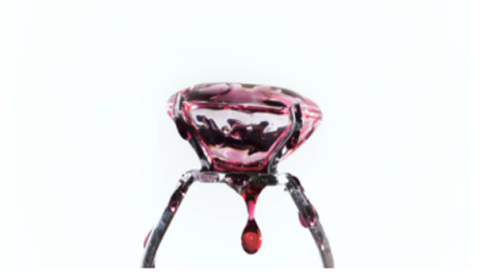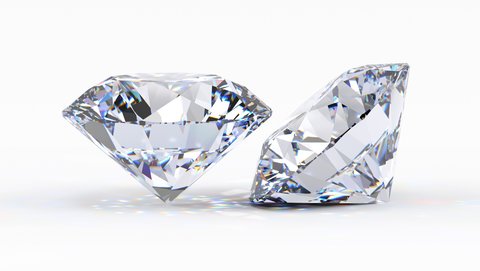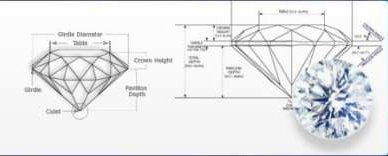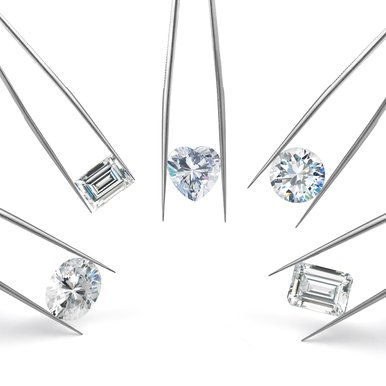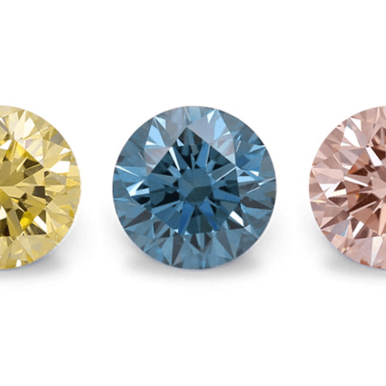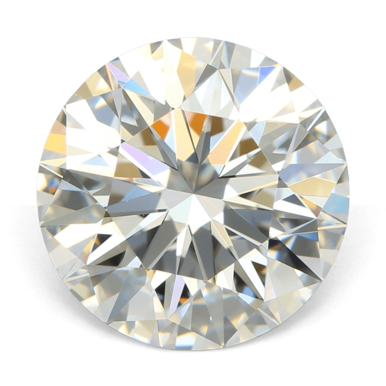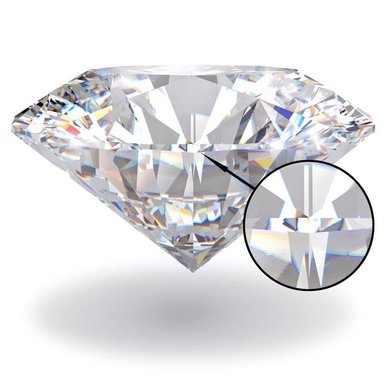Trapezoid Diamonds: The Elegant Accent Stone for Modern Jewelry
Trapezoid Cut Lab-Grown Diamonds
Trapezoid diamonds represent the perfect fusion of geometric precision and sparkling brilliance in modern jewelry design. These uniquely shaped stones have gained significant popularity in recent years as sophisticated accent stones that enhance and magnify the beauty of center diamonds. At Labrilliante, we've seen growing demand for these distinctive lab-grown diamonds as discerning customers seek jewelry pieces that stand out while maintaining elegant symmetry.
Trapezoid diamonds derive their name from their distinctive four-sided shape with two parallel sides of different lengths. This geometric precision creates a visual flow that naturally draws the eye toward the center stone in multi-stone settings. Whether framing a stunning emerald-cut lab-grown diamond or complementing a round brilliant centerpiece, trapezoid diamonds add architectural interest and increased brilliance to any jewelry design.
Throughout this comprehensive guide, we'll explore everything you need to know about trapezoid diamonds: their definition and characteristics, the different types available, popular jewelry applications, selection criteria, setting considerations, comparisons with other side stones, maintenance tips, and answers to frequently asked questions. By the end, you'll understand why trapezoid lab-grown diamonds from Labrilliante represent an excellent choice for creating distinctive, eye-catching jewelry pieces.
What is a Trapezoid Diamond?
A trapezoid diamond is a distinctive fancy-cut gemstone characterized by its four-sided geometric shape with two parallel sides of different lengths and two non-parallel sides. This unique configuration creates a stone that visually tapers from its wider base to its narrower top (or vice versa), producing an elegant, architectural appearance. At Labrilliante, our lab-grown trapezoid diamonds maintain precise proportions to ensure optimal light performance and visual appeal.

While technically defined by their geometric shape, trapezoid diamonds occupy a special place in the diamond world between classic cuts and more unusual fancy shapes. They share some characteristics with baguette diamonds but differ in their trapezoidal outline rather than the rectangular form of baguettes. They also differ from trillion cuts, which have a triangular shape, and half-moon cuts, which feature a curved edge.
The history of trapezoid diamonds dates back to the early 20th century when advances in diamond cutting technology allowed for more precise faceting patterns and greater creativity in shape design. They gained prominence in the Art Deco era of the 1920s and 1930s, when geometric patterns and symmetrical designs were highly fashionable. During this period, trapezoid diamonds were often used in conjunction with other fancy cuts to create bold, architectural jewelry pieces.
Today, trapezoid diamonds have evolved from their historical roots to become sophisticated accent stones that enhance modern jewelry designs. At Labrilliante, our dedication to sustainable, lab-grown trapezoid diamonds continues this tradition of excellence while embracing ethical and environmental values that resonate with today's discerning customers.
When properly cut, trapezoid diamonds offer a wonderful balance of brilliance and geometric precision, making them ideal companions for a variety of center stone shapes. Their distinctive form allows them to both contrast with and complement other diamond shapes, creating visual interest while maintaining harmony in the overall design.
Types of Trapezoid Diamonds
Trapezoid diamonds come in several distinctive varieties, each with unique characteristics that make them suitable for different jewelry applications. At Labrilliante, we offer two primary types of lab-grown trapezoid diamonds to suit various design aesthetics and center stone pairings.

Step Cut Trapezoids
Step cut trapezoid diamonds feature parallel facets that resemble a staircase, creating an elegant, architectural appearance. These diamonds are characterized by:
- Linear facet patterns arranged in parallel steps
- Clean, geometric lines that enhance the diamond's shape
- Exceptional clarity due to their "window-like" appearance
- A sophisticated, understated brilliance
- Excellent pairing with other step-cut center stones
Step cut trapezoids from Labrilliante are particularly well-suited for pairing with emerald or asscher cut center stones, as they create a cohesive, architectural aesthetic that highlights the geometric precision of the overall design.
Brilliant Cut Trapezoids
Brilliant cut trapezoid diamonds feature a faceting pattern similar to that of round brilliant diamonds, but adapted to the trapezoidal shape. These diamonds offer:
- Numerous triangular facets designed to maximize light return
- Enhanced sparkle and fire compared to step cuts
- Greater forgiveness for inclusions due to the faceting pattern
- Versatile pairing options with many center stone shapes
- Excellent light performance even in smaller sizes
Labrilliante's brilliant cut trapezoids are ideal companions for round, oval, cushion, or pear-shaped center stones, providing a harmonious transition while adding their own distinctive sparkle.
Crescent Trapezoids
A specialized variation is the crescent trapezoid, which features:
- One curved edge that follows the contour of a round center stone
- Three straight edges that maintain the trapezoidal shape
- A custom-fit appearance around circular center diamonds
- Seamless visual flow in three-stone settings
Comparison of Trapezoid Diamond Types
| Feature | Step Cut Trapezoids | Brilliant Cut Trapezoids | Crescent Trapezoids |
|---|---|---|---|
| Facet Pattern | Parallel "steps" | Triangular facets | Mixed, with curved edge |
| Brilliance Level | Moderate | High | Moderate to High |
| Best Center Stone Pairing | Emerald, Asscher | Round, Oval, Cushion, Pear | Round |
| Clarity Importance | High | Moderate | Moderate |
| Visual Effect | Architectural, clean | Sparkling, dynamic | Custom, flowing |
| Unique Advantage | Elegant symmetry | Maximum brilliance | Perfect contour fit |
At Labrilliante, our expert gemologists carefully craft each lab-grown trapezoid diamond to ensure optimal proportions and faceting regardless of the cut style. This attention to detail guarantees that our trapezoid diamonds achieve their full potential for beauty and light performance.

Uses of Trapezoid Diamonds in Jewelry
Trapezoid diamonds are prized for their versatility and ability to enhance various jewelry designs. At Labrilliante, our lab-grown trapezoid diamonds are predominantly used in several key applications that showcase their unique geometric beauty.
Three-Stone Engagement Rings
The most popular and iconic use for trapezoid diamonds is in three-stone engagement ring settings. In these designs:
- Trapezoid diamonds flank a larger center stone on each side
- They create a visual flow that draws the eye to the center diamond
- The graduated size arrangement creates a sense of balance and harmony
- Their tapered shape allows for a comfortable fit on the finger
- The additional stones increase the ring's total carat weight and sparkle
Complementary Center Stone Shapes
Trapezoid diamonds pair exceptionally well with specific center stone shapes, creating cohesive and balanced designs:
- Emerald and Asscher Cuts: Step-cut trapezoids create a seamless aesthetic with these rectangular center stones, enhancing their geometric precision.
- Oval and Pear Shapes: Brilliant-cut trapezoids provide a perfect transition between the curved outlines of these shapes and the straight lines of the band.
- Round Brilliants: Crescent trapezoids follow the contour of round stones for a custom-fit appearance.
- Princess and Cushion Cuts: Traditional trapezoids offer a complementary contrast to these squared shapes.
- Radiant Cuts: The mixed cutting style of radiants pairs beautifully with either step or brilliant trapezoids.
Alternative Jewelry Applications
Beyond the classic three-stone setting, Labrilliante's trapezoid diamonds also excel in:
- Halo Designs: Used as transitional elements in geometric halo settings
- Five-Stone Bands: Creating an elegant graduation of shapes across the finger
- Earrings: Paired with larger center stones in drop or stud styles
- Pendants: Framing a center stone for dimensional appeal
- Men's Jewelry: Adding sophisticated detail to men's bands or cufflinks
- Custom Pieces: Creating one-of-a-kind jewelry with distinctive geometric patterns
Notable Trapezoid Diamond Jewelry
While not widely known as center stones, trapezoid diamonds have made appearances in several notable jewelry pieces. At Labrilliante, we've created custom designs inspired by these iconic examples, adapting them for our ethically sourced, lab-grown diamonds.
One particularly memorable piece is our "Architectural Trilogy" ring, featuring a 2-carat emerald-cut lab-grown diamond center stone with perfectly matched trapezoid side stones. This design exemplifies the elegant symmetry and refined brilliance that trapezoid accents can bring to a significant center stone.
Impact on Overall Design
The inclusion of trapezoid diamonds in jewelry design offers several visual advantages:
- They create directional flow, guiding the eye across the piece
- Their geometric precision adds architectural interest
- They provide a smooth transition between different elements
- They enhance the perceived size of the center stone
- They add sparkle without competing with the main diamond
Recommended Trapezoid Pairings with Center Stones
| Center Stone Shape | Recommended Trapezoid Type | Visual Effect |
|---|---|---|
| Emerald Cut | Step Cut Trapezoid | Harmonious geometric precision |
| Asscher Cut | Step Cut Trapezoid | Architectural symmetry |
| Round Brilliant | Crescent or Brilliant Trapezoid | Smooth contoured transition |
| Oval | Brilliant Trapezoid | Complementary sparkle |
| Princess Cut | Brilliant or Step Trapezoid | Interesting shape contrast |
| Cushion Cut | Brilliant Trapezoid | Enhanced center stone focus |
| Pear Shape | Brilliant Trapezoid | Balanced asymmetry |
| Radiant Cut | Step or Brilliant Trapezoid | Cohesive light performance |
Choosing the Right Trapezoid Diamonds
Selecting the perfect trapezoid diamonds requires attention to several key factors that affect their appearance and performance. At Labrilliante, we guide our customers through these considerations to ensure they find lab-grown trapezoid diamonds that perfectly complement their jewelry designs.
![ideal size proportions between center stone and trapezoid side stones]](/fileadmin/_processed_/0/7/csm_ideal_size_proportions_between_center_stone_and_trapezoid_side_stones__5bf62b3ef8.jpg)
Size and Proportion
The size of trapezoid diamonds should be proportionate to the center stone they accompany:
- Ideally, trapezoid side stones should measure approximately 1/3 to 1/2 the length of the center stone
- Width-to-length ratio typically ranges from 1:1.8 to 1:2.2 for most aesthetically pleasing results
- Depth percentage affects both brilliance and perceived size
- Proper proportions ensure visual balance in the completed piece
The Importance of Matching Pairs
For most jewelry designs, trapezoid diamonds are used in pairs, making matching critical:
- Dimensions should be identical or within 0.1mm tolerance
- Cut style and facet patterns should be consistent between the pair
- Color grades should be within the same grade for a cohesive appearance
- Clarity grades should be similar to ensure no visible difference
At Labrilliante, our lab-grown trapezoid diamonds are carefully selected and matched to create perfect pairs, eliminating the challenge of finding natural matching trapezoids.
Color Considerations
Color selection for trapezoid diamonds depends on several factors:
- For white diamonds, color grades from D-F are ideal for step cuts, which show color more readily
- G-H color grades work well for brilliant cut trapezoids, which mask color better
- For three-stone rings, match color grades with the center stone or go slightly warmer
- Consider setting metal when selecting color (white metals with higher color grades, yellow or rose gold with warmer diamonds)
Clarity Selection
Clarity is particularly important for trapezoid diamonds due to their shape and typical cutting styles:
- Step cut trapezoids should have higher clarity (VS2 and above) due to their window-like appearance
- Brilliant cut trapezoids can accommodate slightly lower clarity grades (SI1 and above)
- Eye-cleanliness is always the priority regardless of the technical grade
- Inclusion location matters more than in other shapes—avoid inclusions along the longer edges
Symmetry and Craftsmanship
The quality of cut and overall symmetry significantly impact a trapezoid diamond's beauty:
- Facets should be crisp and properly aligned
- The outline should be precisely geometric with clean, straight edges
- Table and pavilion facets should create proper light return
- Polishing should be excellent to maximize brilliance
Selection Guide for Trapezoid Diamonds
| Feature | Step Cut Trapezoids | Brilliant Cut Trapezoids |
|---|---|---|
| Ideal Color Grade | D-F | D-H |
| Minimum Clarity | VS2 | SI1 |
| Width-to-Length Ratio | 1:2 to 1:2.2 | 1:1.8 to 1:2 |
| Polish/Symmetry | Excellent/Very Good | Very Good/Good |
| Carat Size (typical side stones) | 0.20-0.50ct each | 0.15-0.40ct each |
| Key Consideration | Transparency and precision | Sparkle and brilliance |
Selection Based on Center Stone
Selecting trapezoid diamonds that perfectly complement your center stone requires consideration of several factors:
- For Emerald Cut Centers: Choose step-cut trapezoids with matching facet patterns
- For Round Brilliants: Consider crescent trapezoids or brilliant cuts
- For Fancy Shapes: Match the trapezoid's cutting style to the center stone's facet arrangement
- For Colored Centers: Select trapezoid diamonds with slightly higher color grades to create a framing effect
Setting and Mounting Tips for Trapezoid Diamonds
The way trapezoid diamonds are set and mounted significantly impacts their appearance, security, and overall effect in the finished jewelry piece. At Labrilliante, we've refined our setting techniques to showcase our lab-grown trapezoid diamonds to their best advantage.
Recommended Setting Styles
Different setting styles offer various advantages for trapezoid diamonds:
- Prong Settings: Three-prong or four-prong settings provide maximum light exposure while securely holding the trapezoid in place.
- Channel Settings: Offer protection along the edges while creating a smooth, continuous look.
- Bezel Settings: Provide maximum security and a contemporary, sleek appearance.
- Bar Settings: Create an architectural look while offering good protection.
[INSERT IMAGE: Close-up examples of different setting styles for trapezoid diamonds]
Metal Selection Considerations
The choice of metal for trapezoid diamond settings affects both aesthetics and durability:
- Platinum: Excellent durability and a naturally white color that complements the brilliance of lab-grown trapezoid diamonds.
- White Gold: A popular and cost-effective option that provides a bright white backdrop.
- Yellow Gold: Creates a warm contrast that can enhance certain color grades of trapezoid diamonds.
- Rose Gold: Offers a romantic, vintage feel that works well with trapezoid shapes.
At Labrilliante, we recommend platinum or 18K white gold for step-cut trapezoid diamonds to enhance their clean, crisp appearance, while all metal colors work beautifully with brilliant-cut trapezoids.
Mounting Challenges and Solutions
Trapezoid diamonds present unique mounting challenges that require expert craftsmanship:
- Secure Positioning: Their tapered shape requires precise mounting to prevent rotation.
- Even Alignment: Both trapezoids must be perfectly aligned with the center stone.
- Proper Spacing: The gap between stones must be consistent and proportional.
- Angle Setting: Trapezoids should be set at angles that complement the center stone's shape.
Our master jewelers at Labrilliante address these challenges through precise measurements, custom-crafted settings, and meticulous attention to detail.
Professional Craftsmanship Importance
The quality of craftsmanship in mounting trapezoid diamonds cannot be overstated:
- Professional setting ensures proper alignment and symmetry
- Expert prong placement maximizes security without obscuring the diamond
- Precise metalwork creates clean lines that enhance the geometric nature of trapezoids
- Proper height setting allows for maximum light entry from below
Setting Recommendations for Trapezoid Diamonds
| Center Stone Shape | Recommended Setting Style | Ideal Metal | Special Considerations |
|---|---|---|---|
| Emerald Cut | Four-prong or bar setting | Platinum or White Gold | Maintain parallel alignment |
| Round Brilliant | Three-prong or bezel | Any precious metal | Angle for visual flow |
| Oval | Four-prong or channel | White metals | Position to enhance length |
| Princess Cut | Channel or bar setting | Platinum or White Gold | Secure corners carefully |
| Cushion Cut | Four-prong or bezel | Any precious metal | Match height precisely |
CAD Design Process
At Labrilliante, we utilize advanced Computer-Aided Design (CAD) technology to ensure perfect mounting of trapezoid diamonds:
- 3D modeling allows for precise alignment visualization
- Digital measurements ensure perfect proportional relationships
- Virtual testing identifies potential issues before production
- Custom design capabilities accommodate unique stone combinations
This technological approach, combined with traditional handcrafting techniques, ensures that our trapezoid diamond settings achieve both precision and artistry.
Trapezoid Diamonds vs. Other Side Stones
When designing jewelry with accent stones, several options are available beyond trapezoid diamonds. At Labrilliante, we offer a range of lab-grown side stone shapes to suit different design preferences, but trapezoid diamonds have distinct advantages in many applications.
Comparison with Baguette Diamonds
Baguette diamonds are perhaps the closest alternative to trapezoids:
- Shape Difference: Baguettes have parallel sides creating a rectangle, while trapezoids have non-parallel sides creating a tapered shape.
- Visual Effect: Trapezoids create directional flow toward the center stone, while baguettes create a more linear frame.
- Versatility: Trapezoids work better with non-rectangular center stones, while baguettes pair best with emerald and princess cuts.
- Light Performance: Both typically utilize step-cut faceting, though trapezoids may offer slightly more brilliance due to their shape.
Comparison with Trillion Diamonds
Trillion-cut diamonds offer a triangular alternative:
- Shape Impact: Trillions create a more dramatic, pointed contrast to the center stone.
- Visual Size: Trillions typically appear larger for their carat weight compared to trapezoids.
- Setting Challenges: Trillion points require special protection, while trapezoids have more balanced durability.
- Center Stone Compatibility: Trillions pair well with round and cushion cuts but can be less versatile than trapezoids.
Comparison with Half-Moon Diamonds
Half-moon diamonds provide a curved alternative:
- Contour Fit: Half-moons offer excellent contour fit for round and oval stones.
- Visual Flow: They create a softer, more fluid appearance than the geometric precision of trapezoids.
- Versatility: Half-moons are primarily suited to round and oval centers, while trapezoids work with many shapes.
- Availability: Lab-grown half-moons can be more challenging to precisely match than trapezoids.
Comparison of Side Stone Options
| Feature | Trapezoid | Baguette | Trillion | Half-Moon |
|---|---|---|---|---|
| Shape | Tapered rectangle | Straight rectangle | Triangle | Curved semi-circle |
| Best Center Stone Pairing | Versatile (emerald, asscher, round, oval) | Rectangular shapes | Round, cushion | Round, oval |
| Visual Effect | Directional, focused | Linear, structured | Dramatic, pointed | Smooth, contoured |
| Light Performance | Moderate to high | Moderate | High | Moderate to high |
| Setting Difficulty | Moderate | Low | High | Moderate |
| Durability | Good | Good | Fair (vulnerable points) | Good |
| Visual Size Per Carat | Moderate | Small | Large | Moderate |
Advantages of Trapezoid Diamonds as Side Stones
Labrilliante's lab-grown trapezoid diamonds offer several distinct advantages over other side stone options:
- Versatile Compatibility: They pair well with more center stone shapes than any other side stone.
- Balanced Aesthetics: They offer a perfect middle ground between dramatic trillions and simple baguettes.
- Directional Flow: Their tapered shape naturally directs attention to the center stone.
- Proportion Control: Their shape allows for easier visual balancing with various center stone sizes.
- Setting Flexibility: They work well in various setting styles, from classic to contemporary.
When to Choose Other Side Stones
While trapezoids are versatile, certain situations may call for alternative side stones:
- Choose baguettes for clean, Art Deco-inspired designs with rectangular center stones.
- Select trillions when looking for maximum visual impact and a contemporary feel.
- Opt for half-moons when working exclusively with round center stones for a perfect contour fit.
At Labrilliante, our design consultants can help you evaluate which side stone shape will best achieve your desired aesthetic while complementing your chosen center stone.
Care, Maintenance, and Buying Tips for Trapezoid Diamonds
Proper care and informed purchasing decisions ensure that your trapezoid diamond jewelry remains beautiful for generations. At Labrilliante, we provide comprehensive guidance to help our customers maintain their lab-grown diamond jewelry and make informed buying decisions.
Cleaning and Protecting Trapezoid Diamonds
Trapezoid diamonds require specific care considerations due to their shape and typical mounting:
- Regular Cleaning: Clean your trapezoid diamond jewelry every 2-3 weeks using mild soap, warm water, and a soft toothbrush.
- Professional Cleaning: Schedule professional cleaning twice yearly to maintain optimal brilliance.
- Ultrasonic Cleaner Use: Step-cut trapezoids with good clarity are generally safe for ultrasonic cleaners, but brilliant-cut trapezoids with inclusions may require gentler methods.
- Prong Protection: Check prongs regularly for security, as trapezoid diamonds' tapered shape can lead to loosening over time.
- Storage Considerations: Store trapezoid diamond jewelry separately from other pieces to prevent scratching.
Inspection Schedule
Due to their role as side stones, trapezoid diamonds require regular checks:
- Examine prong security monthly, especially in three-stone rings
- Check alignment with the center stone quarterly
- Inspect for any signs of chips along the edges biannually
- Confirm that the settings remain level annually
Buying Considerations for Trapezoid Diamonds
When purchasing jewelry featuring trapezoid diamonds, consider these factors:
- Certification: Ensure lab-grown trapezoid diamonds come with proper certification.
- Matching Quality: Verify that pairs are perfectly matched in size, color, and clarity.
- Cut Precision: Examine the symmetry and proportions under magnification.
- Setting Security: Check that the mounting holds the diamonds securely without excessive metal.
- Price Comparison: Understand that well-cut trapezoid diamonds command a premium over simpler cuts.
At Labrilliante, all our lab-grown trapezoid diamonds are certified, precisely cut, and professionally matched to ensure exceptional quality.
Custom Orders and Matching Services
For specialized needs, consider custom services:
- Custom Cutting: Trapezoid diamonds can be custom-cut to specific dimensions for unique designs.
- Replacement Matching: If one trapezoid is lost or damaged, professional matching services can create a replacement.
- Design Consultation: Expert advice can help determine the optimal trapezoid specifications for your jewelry.
Labrilliante offers comprehensive custom design services for trapezoid diamond jewelry, ensuring perfect proportions and matching for any center stone.
Lab-Grown vs. Natural Trapezoid Diamonds
Lab-grown trapezoid diamonds offer several advantages over their natural counterparts:
- Consistent Availability: Easier to find perfectly matched pairs
- Ethical Sourcing: Free from concerns about mining practices
- Environmental Impact: Significantly reduced carbon footprint
- Value Proposition: More value per dollar invested
- Quality Control: Greater consistency in cut quality and symmetry
Our Labrilliante lab-grown trapezoid diamonds provide all these benefits while maintaining identical physical, chemical, and optical properties to natural diamonds.
Buying Checklist for Trapezoid Diamond Jewelry
| Consideration | What to Look For |
|---|---|
| Matching | Perfect symmetry between pairs |
| Proportions | Width-to-length ratio appropriate for center stone |
| Setting Security | Proper prong placement and metal reinforcement |
| Color Grade | Matches or complements center stone |
| Clarity | VS2+ for step cuts, SI1+ for brilliant cuts |
| Certification | Proper documentation of specifications |
| Cut Quality | Crisp facets with excellent symmetry |
| Return Policy | Clear terms for size adjustments or design changes |
FAQ Trapezoid Cut Lab Grown Diamonds
Trapezoid diamonds generally don't sparkle as much as round brilliant diamonds, especially if they're step-cut. Step-cut trapezoids offer elegant flashes of light rather than intense sparkle, while brilliant-cut trapezoids have more fire but still don't match round diamonds. This is because round brilliants have an ideal facet arrangement specifically designed to maximize light return, whereas trapezoids prioritize their distinctive shape and architectural appeal.
Yes, trapezoid diamonds can be used as center stones, though this is uncommon. Their distinctive geometric shape makes them challenging to set as solitaires, but at Labrilliante, we've created striking designs featuring larger trapezoid lab-grown diamonds as center stones in contemporary settings. These designs appeal to customers seeking unique, architectural jewelry that stands apart from traditional styles.
Trapezoid diamonds look best when set to emphasize their geometric precision. For step-cut trapezoids, prong settings that minimize metal coverage work well, while brilliant-cut trapezoids can be enhanced with channel or bezel settings. The height should allow maximum light entry from below, and trapezoids should be positioned to create visual flow toward any center stone. At Labrilliante, we carefully angle each trapezoid to create perfect symmetry and balance.
The ideal size ratio for trapezoid side stones is typically 1/3 to 1/2 the length of the center stone. This proportion creates visual balance while ensuring the side stones enhance rather than compete with the center diamond. For example, a 7mm emerald-cut center stone pairs beautifully with trapezoids measuring 3-3.5mm in length. At Labrilliante, our design consultants can recommend the perfect proportions for your specific center stone.
Trapezoid diamonds command higher prices than baguettes of similar weight due to their more complex cutting process. Their tapered shape requires removing more of the original rough diamond, resulting in greater material loss. Additionally, creating perfectly matched trapezoid pairs demands exceptional skill and precision. Lab-grown trapezoid diamonds from Labrilliante offer better value while maintaining the same quality and visual appeal as natural diamonds.
Securing trapezoid diamonds is a particular concern due to their tapered shape. At Labrilliante, we use several techniques to ensure long-term security: reinforced prongs specifically designed for the trapezoidal form, strategic placement of metal along vulnerable points, custom-fitted bezels for certain designs, and precise tension calibration in channel settings. Additionally, we recommend bi-annual professional inspections to check and tighten settings as needed.
Absolutely! Trapezoid diamonds pair beautifully with colored gemstone centers, creating striking contrast. For the most elegant combination, choose colorless (D-F) trapezoid diamonds to frame vibrant sapphires, emeralds, or rubies. The geometric precision of trapezoids particularly complements the structured beauty of emerald-cut colored gemstones. Labrilliante's lab-grown trapezoid diamonds provide exceptional brilliance that enhances any colored center stone.
Trapezoid diamonds have seen a significant resurgence in popularity as modern jewelry design embraces geometric precision and architectural elements. While initially popular during the Art Deco era, trapezoids have experienced renewed appreciation in contemporary three-stone ring designs. Today's trends favor cleaner lines and distinctive shapes, making trapezoids increasingly sought-after as sophisticated accent stones. Labrilliante has responded to this trend with an expanded collection of precision-cut lab-grown trapezoid diamonds in various sizes.


